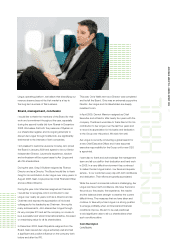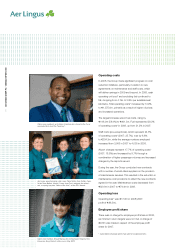Aer Lingus 2008 Annual Report Download - page 15
Download and view the complete annual report
Please find page 15 of the 2008 Aer Lingus annual report below. You can navigate through the pages in the report by either clicking on the pages listed below, or by using the keyword search tool below to find specific information within the annual report.
AER LINGUS GROUP PLC - ANNUAL REPORT 2008
13
the European Parliament voted in favour of including
aviation emissions in the European Union’s (EU) Emission
Trading Scheme (ETS) as of 2012. The ETS is one of the
mechanisms whereby the EU seeks to meet its emission
reduction targets under the Kyoto Protocol. The directive
will require all flights both intra EU and into and out of EU
airspace to participate in a carbon cap-and-trade scheme.
The directive, which was formally approved by Council
on 24 October 2008, entered into force in February 2009
and member states have 12 months to put it into national
legislation. In 2009 airlines will be required to submit
monitoring plans for emissions to the appropriate authority
in their member state.
Included in the directive also are the following:
n Emissions reduction targets will be based on average
annual emissions between 2004-2006 and will be cut
by 3% in 2012, and then by 5% from 2013 onwards,
subject to review.
n 85% of emissions allowances will be allocated to
airlines for free with 15% to be auctioned off.
n The use of the revenues received from the auctioning
process will be determined by the member states.
If actual emissions are anticipated to exceed their
allowances, airlines must either buy additional emissions
allowances if available in the market, or reduce their
emissions by investing in more efficient technologies
or operational practices.
The Group firmly believes that a well-designed ETS can
contribute to an ethical and equitable management of
emissions and act as a catalyst, enhancing the effectiveness
of other measures. However, we believe that there are a
number of adjustments needed to the current proposals to
fulfil this aim. In particular, we believe that the scheme must:
- use accurate data for the baseline, which should be
moved as close as possible to the trading period, as for
other sectors. The current proposal is to use 2004-
2006 operating data as the basis for assignment of free
emissions. In the first year of operation this data will be
6-8 years out of date and this will penalise airlines that
have expanded operations in the intervening period. In
Aer Lingus’ case, all expansion in this period has been
achieved through the addition of new aircraft, which are
more environmentally friendly. A baseline of 2007-2009
would be more appropriate than 2004-2006.
- limit the scheme to carbon dioxide as the level of
contribution to climate change of other gases from
aviation remains unproven.
- as airlines would be net buyers of allowances, it is critical
that we have the widest possible access to other sectors’
markets in an open ETS.
To be fully effective an ETS must also be supported by
infrastructure change that would further contribute to reduced
emissions. In particular, the implementation of the Single
European Sky policy should be accelerated so as to achieve
the 12% emissions reduction that would result from a better
Air Traffic Management System. Authorities also need to
tackle the problem of airport congestion, which significantly
contributes to unnecessary fuel burn and hence emissions.
Another key success factor in an ETS is that it should be
the single system to regulate airlines’ environmental impact.
Airlines should not be penalised on the double, with further
taxes and charges added on top of the cost of the ETS.
We take our environmental responsibilities very seriously
and are committed to combating climate change through
a focused and comprehensive multi-action strategy. We
continue our efforts to limit the environmental impact of
aviation by investing in new technology and by improving
operational procedures. Specific areas that have been
addressed are outlined on the following pages.
Aer Lingus provides supports to the Special Olympics – Team Ireland’s athletes and volunteers
























